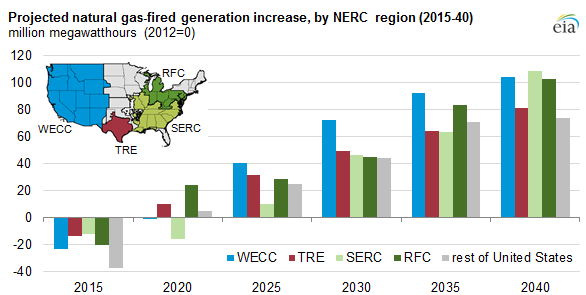The US Energy Information Administration (EIA) forecasts that gas-fired power generation in the United States will increase by an average 1.3%/year until it reaches 1,600 TWh in 2040. This growth will be fed by a strong increase in domestic gas production (+56% from 2012 to 2040) and is spread throughout the Lower 48 states, and the reasons for the growth vary by region.
For the United States, increasing natural gas supply results in unexpected future growth in natural gas-fired electric generation, particularly after 2020. Total U.S. natural gas production increases 56% from 2012 to 2040, largely because of the development of shale gas, tight gas, and offshore natural gas resources.
The three regions with the highest growth in natural gas-fired generation, SERC (South East US, excluding Florida), RFC (Mid-Atlantic and Midwest) and WECC (Rocky Mountains, Pacific Northwest, and south-western United States), also have the highest overall amounts of coal-fired generation. Coal-fired generation still grows significantly in SERC Reliability Corporation (SERC) and ReliabilityFirst Corporation (RFC), despite significant retirements of coal-fired capacity, and the increased cost of building new coal-fired facilities. In the Western Electricity Coordinating Council (WECC), natural gas-fired power competes with renewable sources for future electric power demand, while in the Texas Reliability Entity (TRE) region, natural gas accounts for almost all the growth in new generation.

Source: U.S. Energy Information Administration, Annual Energy Outlook 2014 Reference case
-
-
 Energy and Climate Databases
Energy and Climate Databases- The most comprehensive and up-to-date annual energy database.
- Monitoring of technology providers in H2 supply chain.
- Monthly energy data on key energy markets.
- The most reliable and up-to-date power generation database.
- The essentials of LNG trade at your fingertips.
- Global monitoring of new and existing refineries.
- Analyse energy consumption and efficiency trends at world level. Benchmark countries.
- Have your database developed by a recognised expert of both energy and IT.
-
 Energy - Climate Forecasts
Energy - Climate Forecasts- Instant access to energy and emissions forecasts.
- Strategic, annual wholesale price projections backed by Enerdata's energy modelling expertise and our globally recognised POLES model.
- Wedges module showing a breakdown of the levers enabling to reduce emissions between two scenarios.
- Unique, independent projections of consumption by end-use.
- GHG Marginal Abatement Cost Curves.
- Benefit from proven models to draw your own energy scenarios and anticipate tomorrow’s challenges.
-
 Market Intelligence
Market Intelligence- 110 Energy and climate country reports
- A newsletter to receive the latest updates on evolving technologies and policies.
- Global energy news and analyses curated daily.
- Enerdata’s experts bring you the essentials about your market and competitors.
-
-
-
 Market Analysis
Market Analysis- Understanding key consumption trends and drivers across sectors.
- Granular and exclusive insight to address the most pressing business and strategic issues.
- Expertise in strategic and business intelligence, with fine-tuning to the market’s specificities.
-
 Energy - Climate Scenarios
Energy - Climate Scenarios- Providing the outlook of an energy commodity in mid to long term time horizons.
- Sector and driver specific energy demand forecasting.
- Assess the evolution of energy prices on the international and regional markets, as well as end-users prices.
- Enerdata guides you through pathways to reach climate targets.
- Supporting local authorities in their decarbonisation strategies.
-
 Climate Strategy and Policy Evaluation
Climate Strategy and Policy Evaluation- Cutting-edge quantitative tools and relevant indicators to monitor and evaluate evolutions on worldwide energy markets.
- Analysis of the most cost-effective options to reduce emissions.
- Quantified simulation and analysis of pledges for climate change negotiations.
- Breakdown and analysis of carbon markets.
- Enerdata guides you on the most beneficial policy or investment options.
- Turning climate objectives into concrete action plans.
-
 Training
Training- Understand different policy targets and measures on energy efficiency.
- How to measure energy savings?
- Energy Forecasting is a 2 days training to learn to design and interpret energy forecasts.
- Energy statistics training allowing to create energy balance with supply, transformation and consumption and understanding the international energy statistics regulations.
- Initiation to EnerMED level 1is the training to approach on the most powerful energy demand forecasting model.
-
-
Resource Centre